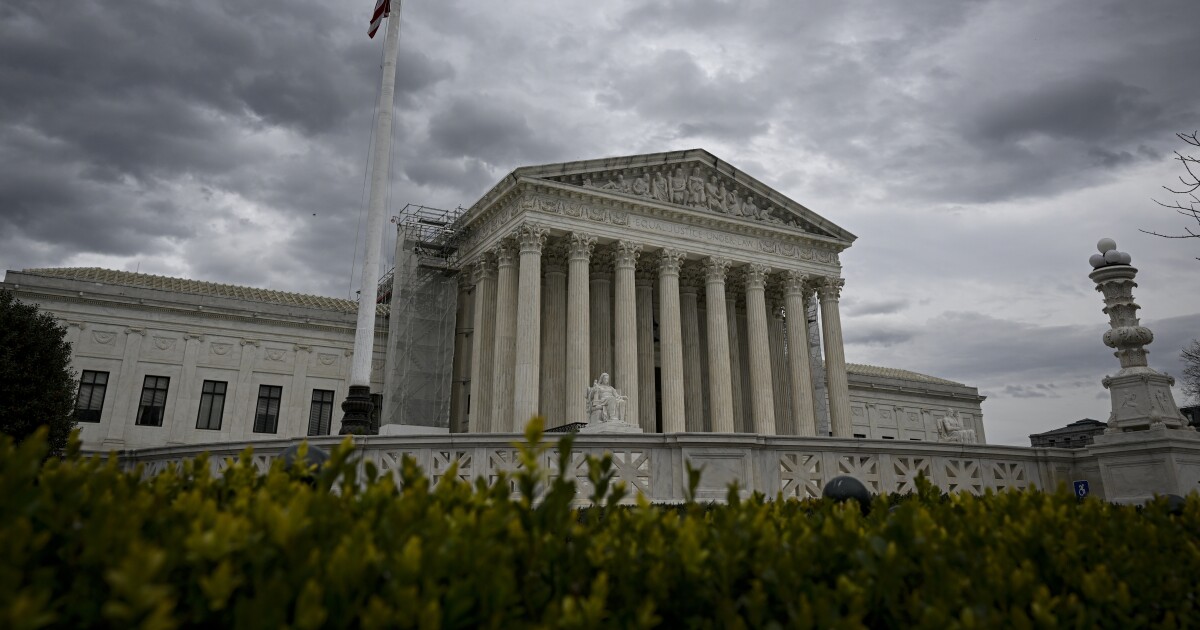Politics
U.S. Supreme Court abortion pill case could impact other drugs

[ad_1]

Abortion is back at the Supreme Court Tuesday. This time anti-abortion doctors are challenging the FDA’s regulatory actionsmaking abortion pills more accessible.
Listen to the arguments, set to begin at 10 a.m. ET
More than half of American women who choose to terminate a pregnancy do so using a two-drug combination of pills. So you might call this case “daughter of Dobbs,” the Supreme Court’s 2022 decision reversing Roe v. Wade and leaving the legality of abortion to the states.
Only this time, there is more at stake than abortion rights. It’s the entire structure of the FDA’s regulatory power to approve drugs and continually evaluate their safety—a system that until now has been widely viewed as the gold standard for both safety and innovation.
On the line, a challenge to the FDA’s scientific expertise
“It would be traumatizing to the system,” says Marsha Henderson, a former FDA associate commissioner for women’s health and a 22-year veteran of the agency.
“We have a very clear scientific approach…it’s not just a helter-skelter set of ad hoc opinions,” Henderson says. “There are teams of scientists and researchers that participate over many years, starting from phase one pre-clinical all the way through post market…and the information, the data evolve, and they collectively help to enhance the whole research world.”
If you start putting politics or junk science into the mix, she warns, the system will collapse.
The challenge in this case was brought by the Alliance for Hippocratic Medicine, an association of anti-abortion doctors founded just months after the Dobbs decision. The group quickly filed a lawsuit seeking to get rid of abortion pills altogether. After a tortuous and tumultuous series of lower court rulings, the Supreme Court intervened to prevent any change to the status quo while it considers the case.
No longer at issue is the FDA’s initial approval of the pill, which occurred nearly a quarter century ago and is no longer subject to challenge. Instead, at issue are many of the conditions which were imposed on the drug when it was first approved, conditions that have since been lifted.
Siding with the FDA in this case are virtually all of the major medical associations in the country, as well as pharmaceutical and bio-tech companies, big and small. On the other side is the Alliance for Hippocratic Medicine, which contends that the FDA’s loosening of restrictions is unjustified and unsafe.
A senator’s wife becomes a new star in the anti-abortion legal world
Arguing in the Supreme Court Tuesday on behalf of the anti-abortion doctors is Erin Hawley, wife of Republican Sen. Josh Hawley.
“Regardless of one’s views on abortion,” she says, “we should want women to take those drugs with sufficient safeguards, as well as want the FDA to do its job.” It didn’t do that, she contends.
The drug at the center of the case is mifepristone, marketed by Danco Laboratories as Mifeprex. There is also a generic version of the drug. Since approving mifepristone 24 years ago, the FDA has authorized changes in the drug’s dosing, and over time, has lifted many of the initial restrictions on dispensing it.
The dosage was changed in 2016 to reduce the amount of mifepristone by two thirds, and to increase the amount of a second drug, misoprostal, a combination that the FDA found decreased serious complications. That change has not been challenged. What is before the court Tuesday are other FDA decisions that over the last seven years have made access to abortion pills easier.
The FDA lifts some restrictions
In 2016, the FDA approved the use of mifepristone for up to 10 weeks of pregnancy, instead of the previous seven weeks; it reduced the required number of in-person visits to doctors from three to one, and lastly, it permitted the drug to be prescribed and dispensed not just by doctors but, in states that allowed it, also by specially certified midwives and nurse practitioners.
In April 2021, at the height of the pandemic, the FDA temporarily dropped the in-person dispensing requirement, citing the health emergency. That allowed patients, who previously had to go to a clinician’s office for their pills, to instead get their prescriptions filled at pharmacies or by mail.
The pandemic changes become permanent
Eight months later, the agency looked at data collected during the “natural experiment” created by the pandemic. It found no difference in serious adverse events whether the drug was dispensed in person or not.
“The safety profile remains the same,” whether the pills were taken after an in-person visit or without one, says Jessica Ellsworth, who represents Danco Labs. In a circumstance like this, Ellsworth adds, the federal law which authorizes the FDA to regulate medications, “specifically directs” the agency to loosen restrictions when they are shown to be unnecessary. That’s what the agency formally did in 2023, after finding that there was no uptick in serious complications after getting rid of the in-person visit requirement.
Hawley, the lawyer for the anti-abortion doctors association, counters that the data the FDA relied on is inadequate to justify the changes that make mifepristone more accessible.
“We have just a couple of years under this regime,” she says. “We have not a lot of data to support it.”
The challenge to the 2016 changes
She also maintains that the data also doesn’t support the 2016 changes—for example, the agency’s decision to increase approval of the drug for use during the first 10 weeks of pregnancy, instead of the original approval for seven weeks.
“The child is larger, the pregnancy tissue is larger, and for that reason, the record shows…that the risk of complications goes up…tenfold from seven weeks to 10 weeks,” Hawley says.
“Not true,” responds Ellsworth, counsel for Danco. “Not true at all.”
She says that in making the 2016 changes—including adjusting the dosing regimen and extending approval for use up to ten weeks of pregnancy—the FDA looked at data that showed fewer complications than when the drug was initially approved for just seven weeks in 2000.
“The number of women who need any follow-up care…went from roughly eight percent to somewhere between two and three percent,” Ellsworth says. “So they’re just wrong when they suggest that there is some kind of additional complications that were brought on by moving to 70 days.”
The procedural hurdle that could throw the case on the dump heap
This entire debate could be for naught at the Supreme Court Tuesday because the anti-abortion doctors first have to get over an important procedural hurdle. Namely, whether they have legal standing to challenge the FDA’s mifepristone decisions, since none of their members prescribe the drug for their patients.
Hawley is adamant that they do have standing. “The fact that our pro-life doctors have oriented their practices and even their lives to avoid elective abortion procedures, I think goes to show that those doctors do have standing here.”
She also maintains that the FDA’s regulations on mifepristone would “conscript” emergency room doctors into performing dilation and curettage procedures after patients come in with incomplete abortions.
But the government counters that the Alliance has been unable to identify a single such occurrence.
No matter which side prevails, a single aspect of this case is truly remarkable. One would be hard pressed to find another case in which the government regulator, the regulated industry, and even the independent watchdog group that frequently criticizes the agency are all on the same side.
“This is a dagger at the heart of the entire industry,” says Jeremy Levin, CEO of Ovid Therapeutics, one of the many pharmaceutical companies siding with the government in the case. If the court rules in favor of the anti-abortion doctors, Levin cautions, “the industry would be thrown into complete disarray. Finding new medicines will be nearly impossible to do.”
A decision in the case is expected by summer.
Copyright 2024 NPR. To see more, visit https://www.npr.org.
[ad_2]
Source link
Politics
Poll: Support for Missouri abortion rights amendment growing

[ad_1]

A proposed constitutional amendment legalizing abortion in Missouri received support from more than half of respondents in a new poll from St. Louis University and YouGov.That’s a boost from a poll earlier this year, which could mean what’s known as Amendment 3 is in a solid position to pass in November.SLU/YouGov’s poll of 900 likely Missouri voters from Aug. 8-16 found that 52% of respondents would vote for Amendment 3, which would place constitutional protections for abortion up to fetal viability. Thirty-four percent would vote against the measure, while 14% aren’t sure.By comparison, the SLU/YouGov poll from February found that 44% of voters would back the abortion legalization amendment.St. Louis University political science professor Steven Rogers said 32% of Republicans and 53% of independents would vote for the amendment. That’s in addition to nearly 80% of Democratic respondents who would approve the measure. In the previous poll, 24% of Republicans supported the amendment.Rogers noted that neither Amendment 3 nor a separate ballot item raising the state’s minimum wage is helping Democratic candidates. GOP contenders for U.S. Senate, governor, lieutenant governor, treasurer and secretary of state all hold comfortable leads.“We are seeing this kind of crossover voting, a little bit, where there are voters who are basically saying, ‘I am going to the polls and I’m going to support a Republican candidate, but I’m also going to go to the polls and then I’m also going to try to expand abortion access and then raise the minimum wage,’” Rogers said.Republican gubernatorial nominee Mike Kehoe has a 51%-41% lead over Democrat Crystal Quade. And U.S. Sen. Josh Hawley is leading Democrat Lucas Kunce by 53% to 42%. Some GOP candidates for attorney general, secretary of state and treasurer have even larger leads over their Democratic rivals.
Brian Munoz
/
St. Louis Public RadioHundreds of demonstrators pack into a parking lot at Planned Parenthood of St. Louis and Southwest Missouri on June 24, 2022, during a demonstration following the Supreme Court’s reversal of a case that guaranteed the constitutional right to an abortion.
One of the biggest challenges for foes of Amendment 3 could be financial.Typically, Missouri ballot initiatives with well-funded and well-organized campaigns have a better chance of passing — especially if the opposition is underfunded and disorganized. Since the end of July, the campaign committee formed to pass Amendment 3 received more than $3 million in donations of $5,000 or more.That money could be used for television advertisements to improve the proposal’s standing further, Rogers said, as well as point out that Missouri’s current abortion ban doesn’t allow the procedure in the case of rape or incest.“Meanwhile, the anti side won’t have those resources to kind of try to make that counter argument as strongly, and they don’t have public opinion as strongly on their side,” Rogers said.There is precedent of a well-funded initiative almost failing due to opposition from socially conservative voters.In 2006, a measure providing constitutional protections for embryonic stem cell research nearly failed — even though a campaign committee aimed at passing it had a commanding financial advantage.Former state Sen. Bob Onder was part of the opposition campaign to that measure. He said earlier this month it is possible to create a similar dynamic in 2024 against Amendment 3, if social conservatives who oppose abortion rights can band together.“This is not about reproductive rights or care for miscarriages or IVF or anything else,” said Onder, the GOP nominee for Missouri’s 3rd Congressional District seat. “Missourians will learn that out-of-state special interests and dark money from out of state is lying to them and they will reject this amendment.”Quade said earlier this month that Missourians of all political ideologies are ready to roll back the state’s abortion ban.“Regardless of political party, we hear from folks who are tired of politicians being in their doctor’s offices,” Quade said. “They want politicians to mind their own business. So this is going to excite folks all across the political spectrum.”
[ad_2]
Source link
Politics
Democrat Mark Osmack makes his case for Missouri treasurer

[ad_1]

Mark Osmack has been out of the electoral fray for awhile, but he never completely abandoned his passion for Missouri politics.Osmack, a Valley Park native and U.S. Army veteran, previously ran for Missouri’s 2nd Congressional District seat and for state Senate. Now he’s the Democratic nominee for state treasurer after receiving a phone call from Missouri Democratic Party Chairman Russ Carnahan asking him to run.“There’s a lot of decision making and processing and evaluation that goes into it, which is something I am very passionate and interested in,” Osmack said this week on an episode of Politically Speaking.Osmack is squaring off against state Treasurer Vivek Malek, who was able to easily win a crowded GOP primary against several veteran lawmakers including House Budget Chairman Cody Smith and state Sen. Andrew Koenig.While Malek was able to attract big donations to his political action committee and pour his own money into the campaign, Osmack isn’t worried that he won’t be able to compete in November. Since Malek was appointed to his post, Osmack contends he hasn’t proven that he’s a formidable opponent in a general election.“His actions and his decision making so far in his roughly two year tenure in that office have been questionable,” Osmack said.Among other things, Osmack was critical of Malek for placing unclaimed property notices on video gaming machines which are usually found in gas stations or convenience stores. The legality of the machines has been questioned for some time.As Malek explained on his own episode of Politically Speaking, he wanted to make sure the unclaimed property program was as widely advertised as possible. But he acknowledged it was a mistake to put the decals close to the machines and ultimately decided to remove them.Osmack said: “This doesn’t even pass the common sense sniff test of, ‘Hey, should I put state stickers claiming you might have a billion dollars on a gambling machine that is not registered with the state of Missouri?’ If we’re gonna give kudos for him acknowledging the wrong thing, it never should have been done in the first place.”Osmack’s platform includes supporting programs providing school meals using Missouri agriculture products and making child care more accessible for the working class.He said the fact that Missouri has such a large surplus shows that it’s possible to create programs to make child care within reach for parents.“It is quite audacious for [Republicans] to brag about $8 billion, with a B, dollars in state surplus, while we offer next to no social services to include pre-K, daycare, or child care,” Osmack said.Here’s are some other topics Osmack discussed on the show:How he would handle managing the state’s pension systems and approving low-income housing tax credits. The state treasurer’s office is on boards overseeing both of those programs.Malek’s decision to cut off investments from Chinese companies. Osmack said that Missouri needs to be cautious about abandoning China as a business partner, especially since they’re a major consumer of the state’s agriculture products. “There’s a way to make this work where we are not supporting communist nations to the detriment of the United States or our allies, while also maintaining strong economic ties that benefit Missouri farmers,” he said.What it was like to witness the skirmish at the Missouri State Fair between U.S. Sen. Josh Hawley and Democratic challenger Lucas Kunce.Whether Kunce can get the support of influential groups like the Democratic Senatorial Campaign Committee, which often channels money and staff to states with competitive Senate elections.
[ad_2]
Source link
Politics
As Illinois receives praise for its cannabis equity efforts, stakeholders work on system’s flaws

[ad_1]

Medical marijuana patients can now purchase cannabis grown by small businesses as part of their allotment, Illinois’ top cannabis regulator said, but smaller, newly licensed cannabis growers are still seeking greater access to the state’s medical marijuana customers.Illinois legalized medicinal marijuana beginning in 2014, then legalized it for recreational use in 2020. While the 2020 law legalized cannabis use for any adult age 21 or older, it did not expand licensing for medical dispensaries.Patients can purchase marijuana as part of the medical cannabis program at dual-purpose dispensaries, which are licensed to serve both medical and recreational customers. But dual-purpose dispensaries are greatly outnumbered by dispensaries only licensed to sell recreationally, and there are no medical-only dispensaries in the state.As another part of the adult-use legalization law, lawmakers created a “craft grow” license category that was designed to give more opportunities to Illinoisans hoping to legally grow and sell marijuana. The smaller-scale grow operations were part of the 2020 law’s efforts to diversify the cannabis industry in Illinois.Prior to that, all cultivation centers in Illinois were large-scale operations dominated by large multi-state operators. The existing cultivators, mostly in operation since 2014, were allowed to grow recreational cannabis beginning in 2019.Until recently, dual-purpose dispensaries have been unsure as to whether craft-grown products, made by social equity licensees — those who have lived in a disproportionately impacted area or have been historically impacted by the war on drugs — can be sold medicinally as part of a patient’s medical allotment.Erin Johnson, the state’s cannabis regulation oversight officer, told Capitol News Illinois last month that her office has “been telling dispensaries, as they have been asking us” they can now sell craft-grown products to medical patients.“There was just a track and trace issue on our end, but never anything statutorily,” she said.
Dilpreet Raju
/
Capitol News IllinoisThe graphic shows how cannabis grown in Illinois gets from cultivation centers to customers.
No notice has been posted, but Johnson’s verbal guidance comes almost two years after the first craft grow business went online in Illinois.It allows roughly 150,000 medical patients, who dispensary owners say are the most consistent purchasers of marijuana, to buy products made by social equity businesses without paying recreational taxes. However — even as more dispensaries open — the number available to medical patients has not increased since 2018, something the Cannabis Regulation Oversight Office “desperately” wants to see changed. Johnson said Illinois is a limited license state, meaning “there are caps on everything” to help control the relatively new market.Berwyn Thompkins, who operates two cannabis businesses, said the rules limited options for patients and small businesses.“It’s about access,” Thompkins said. “Why wouldn’t we want all the patients — which the (adult-use) program was initially built around — why wouldn’t we want them to have access? They should have access to any dispensary.”Customers with a medical marijuana card pay a 1% tax on all marijuana products, whereas recreational customers pay retail taxes between roughly 20 and 40% on a given cannabis product, when accounting for local taxes.While Illinois has received praise for its equity-focused cannabis law, including through an independent study that showed more people of color own cannabis licenses than in any other state, some industry operators say they’ve experienced many unnecessary hurdles getting their businesses up and running.The state, in fact, announced last month that it had opened its 100th social equity dispensary.But Steve Olson, purchasing manager at a pair of dispensaries (including one dual-purpose dispensary) near Rockford, said small specialty license holders have been left in the lurch since the first craft grower opened in October 2022.“You would think that this would be something they’re (the government) trying to help out these social equity companies with, but they’re putting handcuffs on them in so many different spots,” he said. “One of them being this medical thing.”Olson said he contacted state agencies, including the Department of Financial and Professional Regulation, months ago about whether craft products can be sold to medical patients at their retail tax rate, but only heard one response: “They all say it was an oversight.”This potentially hurt social equity companies because they sell wholesale to dispensaries and may have been missing out on a consistent customer base through those medical dispensaries.Olson said the state’s attempts to provide licensees with a path to a successful business over the years, such as with corrective lotteries that granted more social equity licenses, have come up short.“It’s like they almost set up the social equity thing to fail so the big guys could come in and swoop up all these licenses,” Olson said. “I hate to feel like that but, if you look at it, it’s pretty black and white.”Olson said craft companies benefit from any type of retail sale.“If we sell it to medical patients or not, it’s a matter of, ‘Are we collecting the proper taxes?’ That’s all it is,” he said.State revenue from cannabis taxes, licensing costs and other fees goes into the Cannabis Regulation Fund, which is used to fund a host of programs, including cannabis offense expungement, the general revenue fund, and the R3 campaign aiming to uplift disinvested communities.For fiscal year 2024, nearly $256 million was paid out from Cannabis Regulation Fund for related initiatives, which includes almost $89 million transferred to the state’s general revenue fund and more than $20 million distributed to local governments, according to the Illinois Department of Revenue.Medical access still limitedThe state’s 55 medical dispensaries that predate the 2020 legalization law, mostly owned by publicly traded multistate operators that had been operating in Illinois since 2014 under the state’s medical marijuana program, were automatically granted a right to licenses to sell recreationally in January 2020. That gave them a dual-purpose license that no new entrants into the market can receive under current law.Since expanding their clientele in 2020, Illinois dispensaries have sold more than $6 billion worth of cannabis products through recreational transactions alone.Nearly two-thirds of dispensaries licensed to sell to medical patients are in the northeast counties of Cook, DuPage, Kane, Lake and Will. Dual-purpose dispensaries only represent about 20 percent of the state’s dispensaries.While the state began offering recreational dispensary licenses since the adult-use legalization law passed, it has not granted a new medical dispensary license since 2018. That has allowed the established players to continue to corner the market on the state’s nearly 150,000 medical marijuana patients.But social equity licensees and advocates say there are more ways to level the playing field, including expanding access to medical sales.Johnson, who became the state’s top cannabis regulator in late 2022, expressed hope for movement during the fall veto session on House Bill 2911, which would expand medical access to all Illinois dispensaries.“We would like every single dispensary in Illinois to be able to serve medical patients,” Johnson said. “It’s something that medical patients have been asking for, for years.”Johnson said the bill would benefit patients and small businesses.“It’s something we desperately want to happen as a state system, because we want to make sure that medical patients are able to easily access what they need,” she said. “We also think it’s good for our social equity dispensaries, as they’re opening, to be able to serve medical patients.”Rep. Bob Morgan, D-Deerfield, who was the first statewide project coordinator for Illinois’ medical cannabis program prior to joining the legislature, wrote in an email to Capitol News Illinois that the state needs to be doing more for its patients.“Illinois is failing the state’s 150,000 medical cannabis patients with debilitating conditions. Too many are still denied the patient protections they deserve, including access to their medicine,” Morgan wrote, adding he would continue to work with stakeholders on further legislation.Capitol News Illinois is a nonprofit, nonpartisan news service covering state government. It is distributed to hundreds of newspapers, radio and TV stations statewide. It is funded primarily by the Illinois Press Foundation and the Robert R. McCormick Foundation, along with major contributions from the Illinois Broadcasters Foundation and Southern Illinois Editorial Association.
[ad_2]
Source link
-

 Politics2 years ago
Politics2 years agoPrenzler ‘reconsidered’ campaign donors, accepts vendor funds
-
Board Bills1 year ago
2024-2025 Board Bill 80 — Prohibiting Street Takeovers
-

 Board Bills3 years ago
Board Bills3 years ago2022-2023 Board Bill 168 — City’s Capital Fund
-

 Business3 years ago
Business3 years agoFields Foods to open new grocery in Pagedale in March
-

 Business3 years ago
Business3 years agoWe Live Here Auténtico! | The Hispanic Chamber | Community and Connection Central
-

 Entertainment2 years ago
Entertainment2 years agoOK, That New Cardinals/Nelly City Connect Collab Is Kind of Great
-

 Entertainment3 years ago
Entertainment3 years agoSt.Louis Man Sounds Just Like Whitley Hewsten, Plans on Performing At The Shayfitz Arena.
-

 Local News2 years ago
Local News2 years agoFox 2 Reporter Tim Ezell Reveals He Has Parkinson’s Disease | St. Louis Metro News | St. Louis





